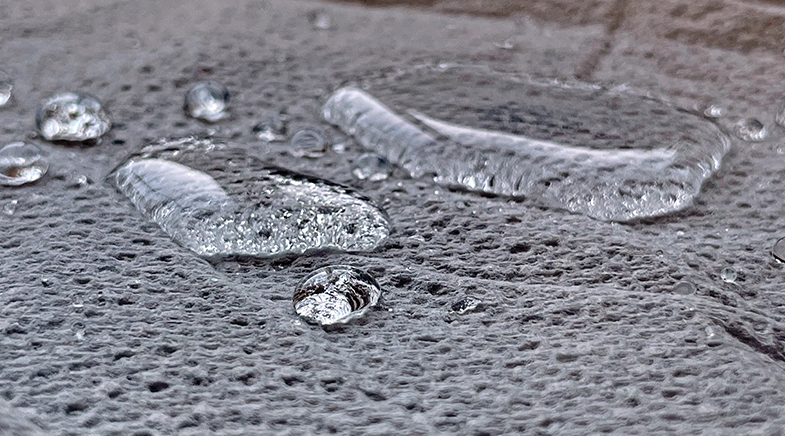Towards a green future
-
- from Shaastra :: vol 02 issue 05 :: Sep - Oct 2023

Scientists are looking at cost-effective and sustainable ways of producing green hydrogen. Using wastewater is one of them.
On the face of it, it sounds like a dream come true. Just about nine litres of water can produce enough hydrogen to fuel your car for a drive from Mumbai to Lonavala. There is a hitch, though — freshwater is a scarce commodity. But when there's a problem, there is often a solution as well.
Hydrogen is seen as the energy of the future, for its fuel emits water and not carbon dioxide. But its generation and use depend on costly and toxic materials. Further, storing and moving pressurised hydrogen lower its efficiency, and transporting it over long distances adds to pollution. And that is why scientists are increasingly looking at ways to produce green hydrogen — made by splitting water into hydrogen and oxygen using electricity from renewable sources, such as solar or wind energy, through electrolysis.
Green hydrogen has been drawing considerable interest across countries. India plans to invest $2.2 billion in the green hydrogen industry, leveraging renewable energy and positioning itself as a leading producer and exporter of sustainable green hydrogen. In 2022, the U.K. launched a $300-million fund for net-zero hydrogen projects. The U.S. set aside over $9.5 billion in 2021 for clean hydrogen. The European Union seeks to produce 10 million tonnes of green hydrogen by 2030.
Placing big bets on technology is not new, but recent history has shown that technological advancements can adversely affect human lives and the environment. Indicatively, Taiwan's semiconductor focus exacerbated a freshwater scarcity; U.S. nuclear programmes generated radioactive waste. Not surprisingly, there are apprehensions about green hydrogen production, too.
But scientists are already addressing some of these concerns. The focus is on finding alternative water sources along with cost-effective and sustainable ways of producing and utilising green hydrogen.
SAVING WATER
Using sunlight is one way. Associate Professor Sudhagar Pitchaimuthu at the Heriot-Watt University, U.K., points out that India can make use of the abundant sunlight available in most parts of the country to directly produce hydrogen, without relying on electricity from renewable sources. The process is known as photoelectrochemistry or photoelectrocatalysis (PEC), in which a catalyst harnesses sunlight to initiate the splitting of water, eliminating the need for electricity.
Pitchaimuthu's fascination for this technology was sparked in 2013, when he was a research fellow with Tokyo University of Science's Akira Fujishima, inventor of the PEC water-splitting process. PEC requires lower input electricity compared to conventional electrolysis for generating green hydrogen. However, for 'true' green hydrogen generation, it is also necessary to eliminate dependence on freshwater.
Some researchers have successfully used seawater or brackish water, but not every region has access to it, and desalination drives up the cost. Experiments have shown that wastewater may work as a substitute. In a 2022 paper in Energies (bit.ly/wasteHydrogen), Pitchaimuthu wrote on the use of PEC to generate green hydrogen and treat wastewater. The process of splitting water is often used at wastewater treatment plants, but the hydrogen generated is seldom captured.
In cities across India, Pitchaimuthu says, millions of litres of wastewater are produced. "We can install the electrolyser (the device that splits water) on site, and feed a part of this wastewater for producing hydrogen," he says. To demonstrate this, he is working with Scottish Water, which treats over one billion litres of wastewater every day, to generate green hydrogen from wastewater for their electric vehicle-testing stations.
In a June 2023 paper on developing innovative electrodes in Industrial & Engineering Chemistry Research (bit.ly/surf-Hydrogen), Pitchaimuthu writes that surfactants in the wastewater are degraded at one electrode, and hydrogen is generated at the other. He hopes that his work will persuade an industry worried about the stability of electrodes in wastewater to adopt this technology.
HUB ON THE ROOF
In Switzerland, researchers are producing hydrogen on the site where it is used to cut down on transport-related emissions. This method also significantly reduces dependence on an electricity grid by using direct sunlight.
Ten years ago, the idea of an artificial tree for generating hydrogen was a Eureka! moment for Sophia Haussener, Associate Professor, Laboratory of Renewable Energy Science and Engineering, Swiss Federal Institute of Technology in Lausanne (EPFL). With Saurabh Tembhurne, then a doctoral assistant at her lab, she co-founded SoHHytec, a start-up providing on-site fully automated green hydrogen production capability. For this, a parabolic mirror— like a vast, inverted umbrella — is placed on a pole to capture the sunlight and concentrate it on a photoelectrochemical device where the water-splitting takes place.

HUB ON THE ROOF
This tree-like structure, called 'Arb' (from Arbor, Latin for tree) can be placed anywhere, including rooftops and parking areas. It has tanks to store the input freshwater and the generated hydrogen and oxygen. It has been deployed in a steel- and metal-making industry, where the hydrogen is produced on site and used directly. In an April 2023 paper in Nature Energy (bit.ly/Arb-Tree), the researchers wrote about a kilowatt-scale solar hydrogen production system using their patented technology.
"Concentration brings cost reduction to the table, and it makes it possible to work with a lesser amount of expensive materials. The small reactor is high in power density, so you make the best use of all your materials and everything around it," Haussener says. Tembhurne, CEO of SoHHytec, adds that its efficiency is twice that of water electrolysis utilising solar energy-derived electricity.
The Arb currently works with freshwater, but Tembhurne states that extensive water management ensures there is no water wastage. The flow of water needed for splitting is used for thermal management. The humidity that accompanies the generation of gases is condensed and utilised.
ECO-FRIENDLY CELLS
Researchers are also trying to make traditional electrolysers cost-effective and sustainable. The Group of Energy Materials at EPFL is working on reducing dependency on expensive catalysts. In a January 2023 paper in Electrochemistry Communications (bit.ly/NickelStainlessSteel), the researchers showed an efficient water-splitting process using stainless steel and nickel, instead of the traditional and more expensive platinum- and iridium-based catalysts. The researchers used anion exchange membrane water electrolysis, where electricity breaks water molecules into hydrogen and oxygen in an alkaline medium.
Doctoral Assistant Suhas Nuggehalli Sampathkumar seeks to scale up this technology — from the size of a shirt button to stacks of cells the size of a sheet of paper. He says that ensuring the materials don't degrade is the key to scaling up. The researchers have applied for a patent for their fluid dynamics system.
Some researchers have successfully used seawater or brackish water... Experiments have shown that wastewater may work as a substitute.
Work is also carrying on in making the use of hydrogen in a fuel cell cheaper and more sustainable. This is the focus of research conducted by Mohammed Ismail, Lecturer in Chemical Engineering, University of Hull, U.K. Ismail is working towards a net-zero carbon economy through hydrogen. He chose to research hydrogen fuel cells during his PhD in 2007, first through numerical modelling, and then through experimental endeavours.
A fuel cell has three components — two electrodes and an electrolyte. The chemical reactions happen at the electrodes, while the electrolyte acts as a medium for ions to pass through between the electrodes. The electrodes use a catalyst to aid the reaction. "The platinum-based catalyst used in the fuel cell and the Nafion (polymer) membrane electrolytes are the cost drivers for the hydrogen fuel cell," Ismail says.
Ismail is working on developing platinum-free, carbon foam-based catalysts for hydrogen fuel cells. His lab optimised the synthesis of these non-precious catalysts, and reported the outcome in Nanotechnology (bit.ly/Fe–N–C). "The performance of this type of catalyst is comparable to that of platinum. But the lifetime is still an issue, and this is something that we are working on," he says.
Ismail notes that the Nafion membrane is expensive and doesn't degrade easily. He is now working on innovating non-precious and biodegradable membrane electrolytes made from materials such as cellulose and biodegradable Poly-Vinyl Alcohol (PVA). In a 2022 paper in Membrane (bit.ly/MembraneCellulose), Ismail's collaborators at the Kyushu University in Japan demonstrated the performance of electrolyte membranes made from cellulose nanocrystals. They achieved ion exchange capacity and conductivity comparable to Nafion; however, they are currently addressing the challenge of stability in humid environments.
What becomes of this technology remains to be seen, but researchers are committed to making it sustainable and ready for wider acceptance.
Have a
story idea?
Tell us.
Do you have a recent research paper or an idea for a science/technology-themed article that you'd like to tell us about?
GET IN TOUCH














